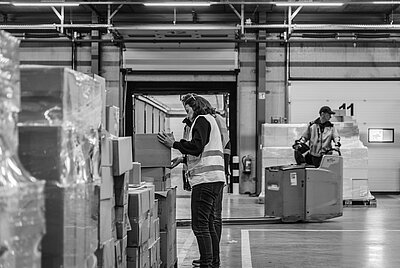The Office of National Statistics in the UK found that despite some variable changes in people’s spending habits – with lockdowns causing huge peaks and troughs in month-on-month spending, retail sales have still grown overall (by 4.2%) on pre-pandemic levels.
This astounding picture is also reflected across the EU, with overall growth overtaking pre-pandemic levels. With retail one of the hardest hit industries during the pandemic, how have some retailers managed to capitalise on this turbulence while others floundered?
While many of the hugely successful retailers in 2021 are already large players in the industry, there are valuable lessons to be learned from their approach. So, we’ve rounded up the biggest influences on retail success in 2021 so you can take forward these lessons into 2022.
Omnichannel
Blending all of your retail experiences (in-store, online, social, telephone) is key to any successful omnichannel approach and it relies on all of those elements working together. But in-store retail experience was hit hard during the pandemic with lockdowns forcing many non-essential retailers to close their stores and put restrictions on in-store numbers and facilities when they did re-open. This presented a real challenge for retailers – how could they continue to offer an in-store shopping experience when there was no in-store to speak of?
It goes without saying that those retailers who had an online presence did far better than those who did not or whose online retail experience was limited. But true success with omnichannel lies in creating a blend of both in-person and online experiences – and finding the niches within that approach that you can capitalise on.
As it happens, the pandemic created the perfect opportunity for this to thrive. We saw in one of our previous insights that click and collect has catapulted many retailers into an omnichannel sweet spot. Within the EU, click and collect turnover doubled pre-COVID estimates to reach a staggering €50 billion.
Click and collect met the most immediate need of people stuck at home, with money to spend but nowhere to spend it, while giving retailers the opportunity to create an in-store experience on a smaller scale. And as the statistics show us, smaller doesn’t mean less. Those retailers that got it right, saw large increases in sales.
It’s impossible to target all areas of omnichannel at once, but by identifying the ones that your customers want you can propel yourself into the fast lane of retail success.
Supply chain management
2021 saw the perfect supply chain storm. A global pandemic, Brexit and the Suez canal blockage all played havoc with trusted supply chains and consumer expectations.
Those retailers that were able to weather the storm had the capability to predict and work with suppliers to keep disruption to a minimum. As we saw in our supply chain insight, great stock management and a diverse supply chain were critical to navigating these issues. But more recently, we showed how British-based homeware chain, B&M, managed to avoid the worst of the supply chain crisis by having critical conversations with suppliers and importing goods earlier than they normally would.
Having a supply chain crisis mitigation strategy became imperative for every retailer in 2021. Gone are the days where normal supply chain issues could be solved by simply finding another supplier; with global events impacting suppliers everywhere, your supply chain strategy needs to be comprehensive and far-reaching for it to be truly effective.
Reactivity
So often, retailers are used to driving trends and dictating purchases before customers even realise it’s what they want or need – but the pandemic turned that on its head. Reacting to customer demand became the biggest dictator of retailer success with customers demanding before many were ready to change.
“Most retailers will have to adopt an attacker’s mindset by deciding which specific customer needs and occasions can provide an arena in which they can outcompete.” Why retail outperformers are pulling ahead, McKinsey.
Whether it’s in your supply chain, your omnichannel approach or your sustainability agenda – you need to be prepared to react quickly to consumer trends in 2022 and beyond. Those who were able to, were often front-runners in technology. We saw how Nike managed to track and divert stock to avoid supply chain issues thanks to its digitised stock management system and the resurgence of RFID in-store to help manage stock levels.
Reactivity has never been so urgent or needed in retail and those who are in a position to react quickly, thanks to technology, emerge as the front-runners. But it doesn’t have to require investment in your own technology.
Some technology was there and ready to capitalise on. Social retail grew at an incredible rate during the pandemic, thanks to the growth in hours people spent on their phones while stuck at home. Reacting to this trend doesn’t require any additional technology investment, but a commitment to using the technology as part of a larger selling strategy.
Sustainability
Another unexpected but largely welcomed trend to emerge from 2021 was the increase in sustainability-led consumerism. In the early stages of 2020, it was hard to ignore the positive impact of the world slowing down. Reductions in CO2 emissions and clear waters in Venice demonstrated the power of people to create change through their habits.
And this trend carried over into retail. Consumers were driven to more sustainable purchases and, perhaps more surprisingly, have continued this trend despite a return to relative normality for large parts of the world. Sustainability isn’t a flash in the pan for retail, and many retailers have worked hard to make it front and centre of their sales agenda. For some retailers, it’s been unavoidable – supply chain problems with cardboard and paper have forced them to re-think packaging and, alongside it, impact from deliveries and the wider supply chain.
But as local stores became micro-fulfilment centres thanks to changes in consumer shopping habits and store closures, it also allowed both consumers and retailers alike to see that a more localised and sustainable approach to shopping is possible despite the growing globalisation of consumerism during the last two decades.
Alongside this is the growing trend for retailers of serious sustainability agendas that don’t just tick boxes. For many, the paper and cardboard supply chain issues forced a change to plastics in some instances. While it was met with dismay from many consumers, it provided the perfect opportunity for retailers to dive in deep to their carbon footprint and take a look at which changes have more impact and then communicate these with customers.
Many found that, if implemented properly, long-term plastic use can often outweigh short-term cardboard. When more and more retailers are being accused of “greenwashing” (faking their green credentials which don’t hold up under scrutiny), the opportunity is ripe for retailers in 2022 to truly understand and communicate their sustainability agenda – leading to more sales and greater customer loyalty.
Our account managers are ready to help you plan for retail success in 2022. You can email at online@worldpack.eu or ring us on +31(0) 88 494 20 80.


